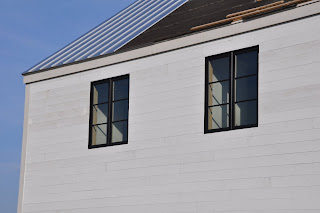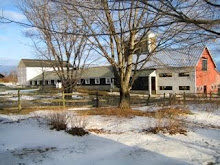

We wanted really nice floors, wood ones that feel great under (sock) foot. It's nice if they wear well, and even better if they can remind us of time, and weather. That is, if they change in response to time or weather. So wood is perfect. It ages and builds patina, it records incidents, like dropped pots and spilled wine, and it shrinks and swells with the seasons.
But really nice wood floors are expensive. So we looked around for a good while before making our decision.
Upstairs, we went with Southern Yellow Pine. This is inexpensive, yet much harder and more durable than Eastern White Pine. After it was laid, it looked a bit like Sweden, but we had another aim. We had it painted, 3 coats of incredibly durable and glossy white enamel. In our sock feet it feels so slick and smooth, and it vacuums up so easily. We love it. And it makes our house bright even on gray days, and this makes the long winter pass a bit easier.
Downstairs, we went with unfinished white oak, a rustic grade I bought from my usual lumber supplier for a very reasonable, cheap even, price. Having some serious milling equipment in my barn, I trimmed all of the boards to width, so I could minimize waste and get some wide boards out of the pile. I had planned to fill the knot holes and sand and oil the whole thing, but it looked so nice as it lay, a really nice Heather color, that we decided to try to live with it unoiled or finished. I presanded all the boards prior to laying, so they feel great underfoot. So far, anytime something has spilled on it, we wipe it up promptly. Oily things leave a mark, and when enough of these things have accumulated, we run over it lightly with a palm sander and it is good as new. By the sink, dishwasher and stove, we have the most messes, so we just bought a 10' runner from the Swedish store in Great Barrington and laid it out in that zone. So far, so good. Worst case scenario? We throw in the towel and oil it all anyway.....
A final note: I got good pricing from a local guy to install the floor, but having the tools, equipment, and free time in the evenings meant I could save a nice chunk of change if I laid it myself. So I did, and I've questioned this wisdom ever since. I enjoyed it ok, and it gave me a sense of accomplishment, but it did delay the project significantly, as for example, plumbing fixtures can't go in until the flooring is down, etc. Given our schedule, it worked out, but if you are in a rush, leave this one to the pros.




 Lengths up to 12' are available, in 4" x 12" dimensions. Rather than have our house telegraph its modularity, by showing a concrete foundation, we designed into the foundation a stone shelf on which to lay these huge slabs of stone. Thus, our house has an apparent stone foundation. It sits on stone, which gives it a sense of eternity.
Lengths up to 12' are available, in 4" x 12" dimensions. Rather than have our house telegraph its modularity, by showing a concrete foundation, we designed into the foundation a stone shelf on which to lay these huge slabs of stone. Thus, our house has an apparent stone foundation. It sits on stone, which gives it a sense of eternity.





 Suddenly the house grew quiet, and the sun bore in. The space warmed up from the heat gain, and I've never looked back. Just out......
Suddenly the house grew quiet, and the sun bore in. The space warmed up from the heat gain, and I've never looked back. Just out......






















 Thank goodness, for then it rained and blew and rained and blew....... and finally, the clouds broke, the fog lifted, and the sun came up.
Thank goodness, for then it rained and blew and rained and blew....... and finally, the clouds broke, the fog lifted, and the sun came up.  Time to side the building!!!!
Time to side the building!!!!  I've said I like things like a thoroughbred - high and tight - and the siding is an important part of that. I want it smooth, almost seamless, but with a little relief. And, given the high winds we have, it must be dead-eye tight. After some tossing and turning, and getting as many varying viewpoints as there are people in the world, I decided to go with
I've said I like things like a thoroughbred - high and tight - and the siding is an important part of that. I want it smooth, almost seamless, but with a little relief. And, given the high winds we have, it must be dead-eye tight. After some tossing and turning, and getting as many varying viewpoints as there are people in the world, I decided to go with  I also decided to
I also decided to 




